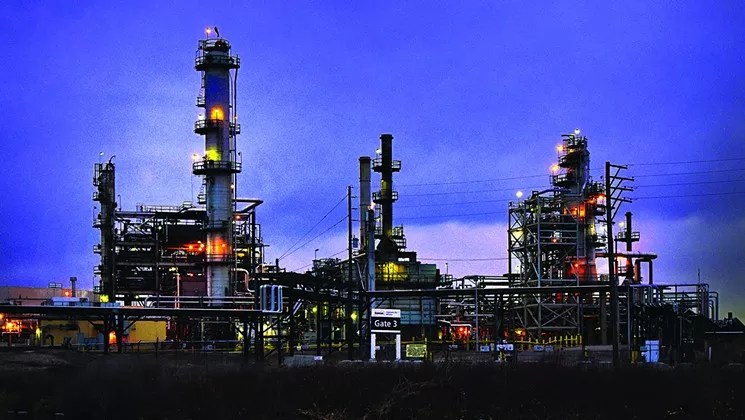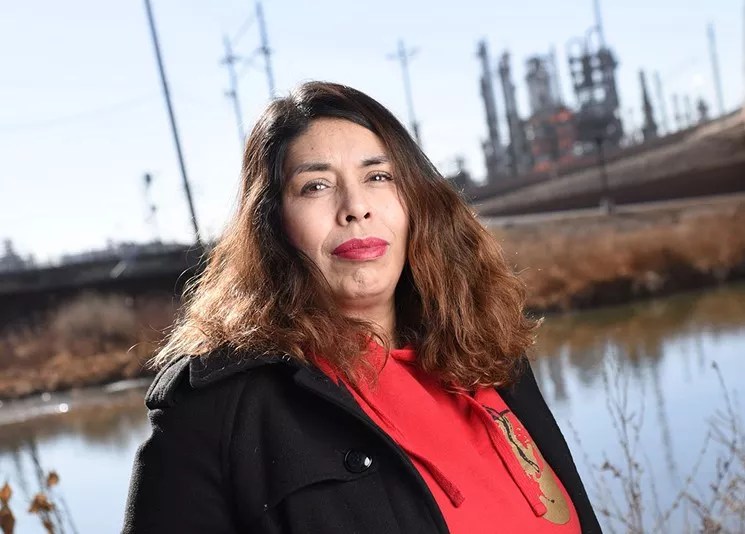
Anthony Camera

Audio By Carbonatix
Commerce City residents gathered on March 30 to reimagine the future of their city without its most infamous landmark: the Suncor oil refinery.
It was no small feat, considering that the refinery, which has been notorious for contaminating air and water through chemical leaks, was established in 1931 – two decades before the area known as Commerce Town became a municipality in 1952.
For years, residents of what today is Commerce City have fought for increased regulation at the industrial plant, and they’ve actually seen some success through community air monitoring. But the refinery is still there, and about to become fully operational again after scaling back operations when equipment problems led to unauthorized emissions in December.
“We need to move beyond just telling the community that their air is dirty,” said Jolie Brawner, director of the Regenerative Recovery Coalition for the Alliance Center, which helped put together the March 30 gathering. “That’s not enough. We want to see more, and we want to let the community lead, and that’s why we’re here tonight.”
Residents showed up in full force, with young people opening the event.
“Our leaders are lacking intelligence,” said Elijah Molina-Moton, nephew of longtime activist Lucy Molina, who was the evening’s emcee. “I’m ten years old, and I get it that there is a climate crisis. … I would like to see a playground here for all of us to play, or maybe a zoo, or Disneyland.”
Molina-Moton shared that he’s worried about global warming, and residents Alexa and Azul Gonzalez – youth activists and sisters from Aurora who came to support the Commerce City residents – agreed, saying there should be more options for kids instead of more air pollution.
“Instead of Suncor, there should be more places like this,” Alexa said of the Eagle Pointe Recreation Center, where the gathering was held. “This place will bring a lot more people and teenagers together who might be suffering with anxiety, depression, and it might help them have better communication with their friends and have a safe place to be and to enjoy activities.”
The common theme among residents: It’s finally time for Suncor to end its reign of terror on Brighton Boulevard.
“We need to become that bridge between our government and the community and also the polluters, the criminals, that have been doing this for what – not five years, five months, but for how long? Decades,” Molina said.
At one point during its long history, Suncor was actually two refineries: one operated by Conoco Phillips and another by Valero. It currently has three plants under its purview: two that transform crude oil into gasoline, diesel and jet fuel, and another that mainly produces asphalt.
“With three plants at two refineries, this facility processes approximately 98,000 barrels/day and contributes $2.5 billion USD to Colorado’s economy annually,” Suncor’s website reads. “We purchase crude oil from the Denver-Julesburg Basin, process it in Commerce City, and sell nearly 95 percent of our products within the state.”
Asked for more information, Loa Esquilin Garcia, senior communications advisor for Suncor, referred Westword to pages on Suncor’s website explaining its history and guidelines.
Before Suncor bought the refinery, it had already been experiencing issues.
The Conoco side of the operation, called the Continental Oil Refinery, exploded in 1978, igniting a fire that killed three people and injured seven. “The explosion sent a 500-foot orange fireball flame into the sky, and even measured 1.5 on the Richter earthquake scale near the office of the U.S.G.S. in Golden, Colorado,” says a Denver Public Library blog on the incident. “Estimates, at that time, were $5 million to $10 million in damages.”
Back then, the refinery supplied 15 percent of the Denver area’s petroleum products. It was cited with fourteen safety violations related to the 1978 fire by the U.S. Occupational Safety and Health Administration for improperly monitoring and operating pressure valves on the site leading up to the incident.
“The refinery was fully reconstructed toward the end of 1980, when capacity was restored to its former 32,000 barrels a day of crude oil,” the DPL piece notes.
As the refinery was being rebuilt, the company that would one day come to own it was founded. In 1979, Suncor was created in Canada through a merger of Sun Oil’s conventional and heavy oil companies. T
In 2003, the Alberta-based company expanded to Commerce City when it purchased the west refinery from Conoco and began upgrading the facility. Two years later, it purchased the east refinery from Valero.
Since then, the refinery has operated under two separate Title V permits from the Environmental Protection Agency, which advocates have long argued makes it harder for the public to hold Suncor accountable. This year, the Colorado Legislature is considering a bill that would expressly allow the Colorado Air Pollution Control Division to combine the two permits held by Suncor, which finally began the permit renewal process in 2022 after years of delays and a lawsuit.
The EPA has been involved with Suncor from the start. Before it purchased the east refinery from Valero, the refinery was sued by EPA officials and the State of Colorado for violations of the Clean Air Act. Suncor had assumed liability to make changes to reduce pollution when it took over Valero.
According to public records on the facility, the refinery regularly exceeds the pollution limits to which it must adhere under its Clean Air Act permit – emitting excess benzene and hydrogen sulfide, which can both cause adverse health effects, including cancer and impacts on the respiratory system.
“Unless we demand more, business will continue as usual,” Molina said on March 30. Her children have missed school because of headaches and breathing problems that she attributes to Suncor.

Lucy Molina is ready to see Suncor leave Commerce City.
Anthony Camera
In December, the refinery experienced equipment damage – causing it to decrease its operations for about two months and go into “safe mode.”
According to Esquilin Garcia, “Safe mode means that we have reduced feedstock and have de-pressurized equipment. During normal operations, the units run on pressure. In safe mode, we maintain a much lower level of pressure to facilitate repairs and a safe and reliable return to operations when that work is complete.”
The Suncor refinery is the only one of its kind in Colorado and processes about 98,000 barrels of oil per day when fully operational, according to its website.
In light of the December closure, Governor Jared Polis issued an executive order relaxing trucking regulations aimed at keeping gas prices down – but prices still went up, as a lack of gasoline coming from the local refinery meant oil had to be shipped in from other states.
Still, activists say gas prices shouldn’t be a factor when considering regulation of the facility.
“Why should our children and our community be sacrificed for cheaper gas prices?” asked Olga Gonzalez, executive director of Cultivando, a nonprofit that operates community air monitors near Suncor, at a March 15 Suncor-related event at the University of Denver.
Cultivando’s community air monitoring program was created out of a $9 million settlement in 2020 between Suncor and the state over excess pollutant emissions.
Suncor was meant to deploy its own fenceline air monitoring program by January 1 – and it has. However, the APCD determined that its proposed monitoring program wasn’t strong enough, requiring it to do more. In response, Suncor sued the state and argued that it couldn’t impose those more stringent requirements.
“The crux of what they were saying is that the Air Pollution Control Division did not have the legal authority under the fenceline monitoring bill to reject the plan that Suncor put forward,” says Ian Coghill, senior attorney with Earthjustice, an environmental nonprofit that has intervened in the case.
APCD does have that authority, according to Coghill, who adds that the voices of impacted community members who advocated for more stringent monitoring deserve to be part of the conversation, too.
When the refinery started firing back up in mid-February, it resulted in emissions over its permit limits.
According to a Suncor Environmental Reportable Events Summary from February 15 to March 15, when Plant 2 started up on February 16, there were exceedances for opacity and carbon dioxide. On March 1 and March 2 – as Plant 1 began to startup – there was an exceedance of sulfur dioxide, which can cause irritation to the eyes, nose and throat.
“This exceedance was due to the presence of small amounts of residual sulfur compounds that were present in the piping, base, burner, and stack of [the incinerator],” the summary says.
As Plant 1 continued to rev back up between March 10 through 14, there were more sulfur dioxide exceedances – as well as exceedances for hydrogen sulfide and opacity, the data shows. However, Suncor says that during all of these events, air monitors in the area did not detect levels over the acute health reference guidelines.
A lack of prompt information about the impacts of the closure and resulting startup have increased distrust between the community and the refinery.
The Colorado Department of Public Health and Environment “should take steps to inform the public about what risks remain and how emissions were impacted during the shutdown,” Earthjustice says in a statement to Westword. “Suncor has demonstrated a lack of concern for worker safety and the surrounding community for years, and its inability to be transparent regarding ongoing risks calls for urgent regulatory action.”
Earthjustice and other activists are now calling on the state to do more to curtail the harm coming from Suncor after nearly a century of environmental contamination.
“It’s time for us to step into the future in Commerce City,” Molina said at the March 30 meeting. “A clean future is possible.”
The community would like to see Suncor close and pay for the remediation of its Commerce City property, and it’s demanding that the state support its quest.
“We must put pressure on our Colorado Department of Public Health and the EPA to actually update regulations that allow them to do their job, which is to protect public health,” Gonzalez said at DU. “Why are we being asked to do the job of government? Why are they being allowed to drop the ball? And why is Suncor being allowed to continue to operate with little to no accountability, or enforcement, of even existing regulations?”